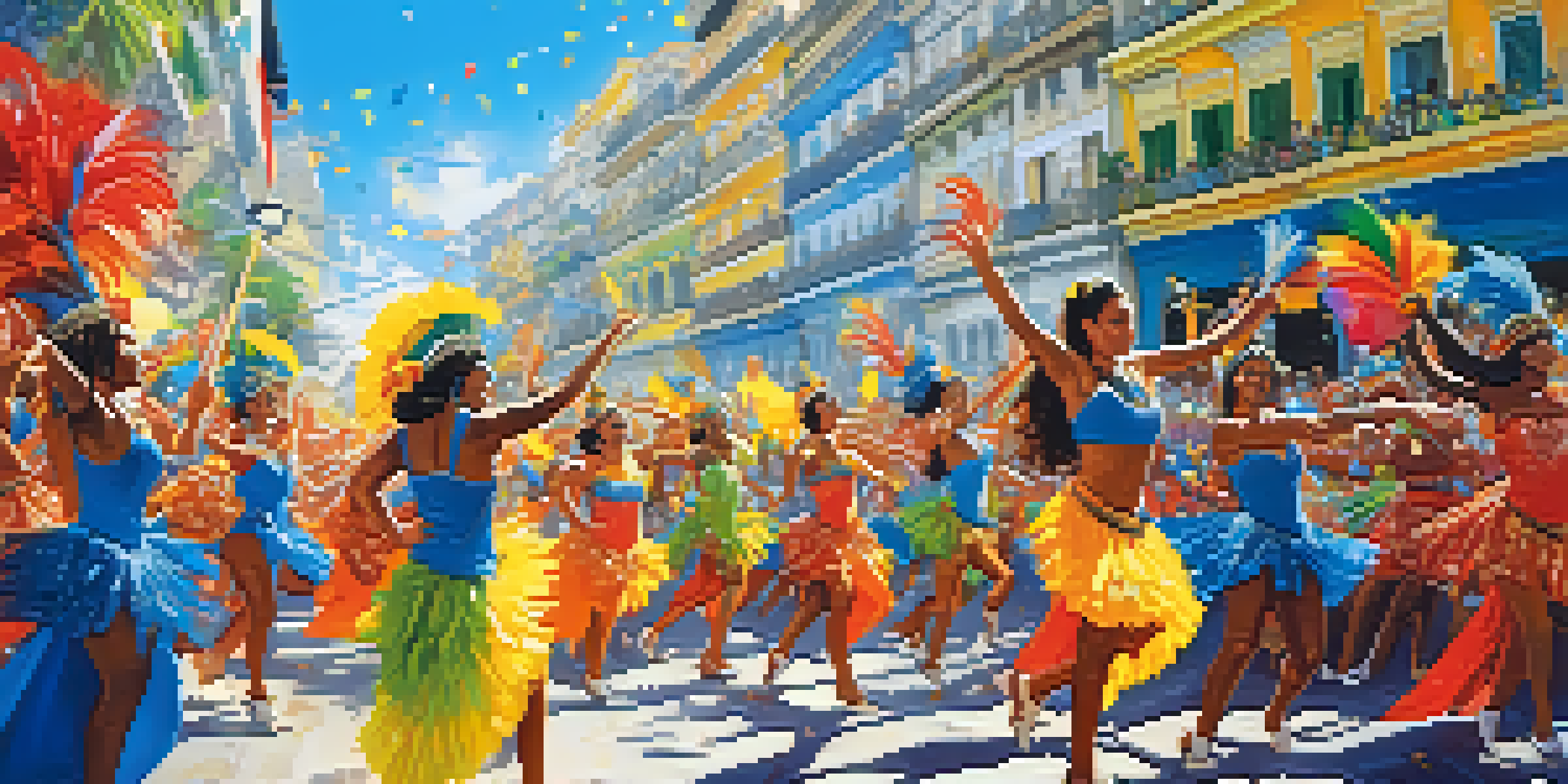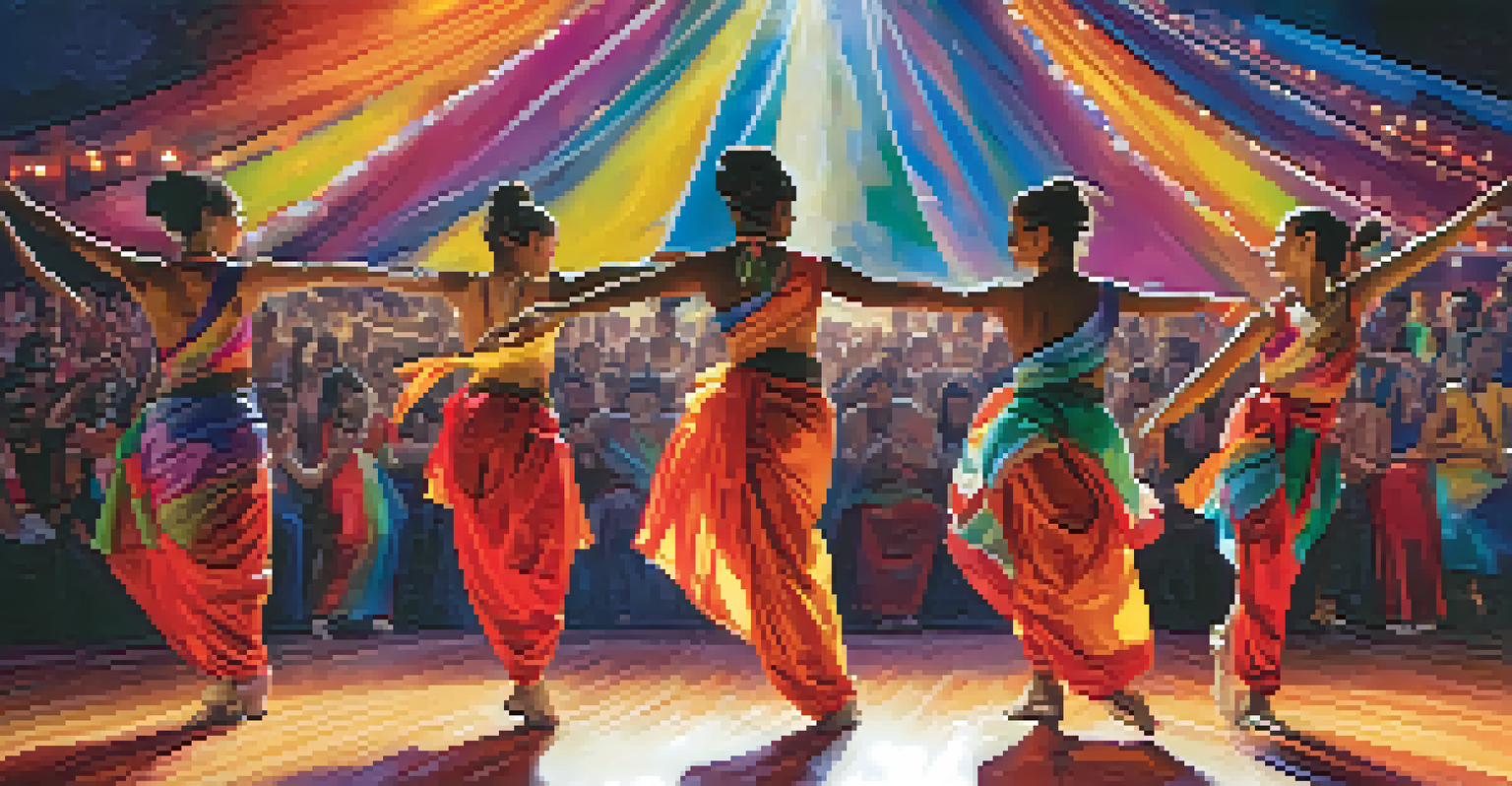Exploring Dance Festivals: A Gateway to Cultural Tourism

The Rise of Dance Festivals in Cultural Tourism
Dance festivals have become a vibrant part of cultural tourism, drawing visitors eager to experience diverse traditions. These events showcase various dance forms, celebrating local customs while attracting global attention. As more people seek authentic experiences, dance festivals stand out as gateways to understanding different cultures.
Dance is the hidden language of the soul.
The growing popularity of these festivals is also fueled by social media, where stunning performances can be shared instantly. This visual appeal not only attracts dancers but also tourists who want to witness the energy and creativity firsthand. Consequently, cities hosting these festivals benefit from increased foot traffic and economic boosts.
Moreover, dance festivals often extend beyond performances, offering workshops, lectures, and cultural exchanges. This immersive approach allows tourists to engage deeply with the local culture, making their experiences memorable. The combination of entertainment and education creates a unique atmosphere that thrives on cultural appreciation.
Top Dance Festivals Around the World to Explore
From the vibrant streets of Rio de Janeiro to the serene temples of Bali, dance festivals can be found worldwide. Some of the most renowned include the Rio Carnival, which features samba parades, and the Ubud Writers & Readers Festival in Indonesia, known for traditional Balinese dance. These festivals not only showcase the art of dance but also highlight the rich cultural narratives behind them.

In Europe, events like the Edinburgh Festival Fringe present a diverse range of dance performances, blending contemporary styles with traditional forms. Each festival offers a unique flavor, inviting tourists to not just watch but also participate in the dance culture. This hands-on involvement fosters a deeper connection between visitors and the host community.
Dance Festivals Boost Cultural Tourism
Dance festivals attract tourists by showcasing diverse traditions and offering authentic cultural experiences.
Additionally, festivals like the Festival de Danse de Cannes in France celebrate both emerging and established artists. This spotlight on talent encourages cross-cultural collaboration and innovation, enriching the global dance landscape. Attending these festivals not only entertains but also educates travelers about the world of dance.
The Economic Impact of Dance Festivals
Dance festivals significantly contribute to the local economy, generating revenue from ticket sales, merchandise, and food vendors. As tourists flock to these events, hotels, restaurants, and transportation services also benefit from the influx of visitors. This economic stimulation often leads to job creation and investment in community development.
The dance is a poem of which each movement is a word.
Moreover, many cities invest in infrastructure improvements to accommodate the growing number of attendees, enhancing the overall visitor experience. This can include better public transport options, upgraded venues, and increased security measures. Such developments not only support the festival but also leave a lasting positive impact on the community.
In the long run, successful dance festivals can establish a city as a cultural tourism hub, attracting more events and visitors year after year. This creates a cycle of growth that benefits both the local economy and the cultural landscape. Ultimately, the economic impact of dance festivals extends well beyond the duration of the event itself.
Cultural Exchange Through Dance Performance
Dance is a universal language, and festivals serve as a platform for cultural exchange. Artists from different backgrounds come together, sharing their unique styles and traditions, which enriches the overall experience. This cross-pollination fosters understanding and respect among diverse communities.
For example, festivals often feature collaborative performances that blend elements from various cultures, creating something entirely new. These innovative presentations not only captivate audiences but also encourage dialogue about the significance of dance in different societies. Such interactions can bridge gaps between cultures, promoting unity through art.
Economic Benefits of Dance Events
These festivals generate significant revenue for local economies, benefiting hotels, restaurants, and community development.
Additionally, workshops and masterclasses at dance festivals provide opportunities for attendees to learn from seasoned performers. This hands-on experience encourages appreciation for the technical aspects of dance and the stories behind each movement. As participants delve into the intricacies of different dance forms, they cultivate a deeper respect for the cultural heritage of the performers.
The Role of Technology in Dance Festivals
In today's digital age, technology plays a crucial role in enhancing the experience of dance festivals. Live streaming allows those unable to attend in person to enjoy performances from the comfort of their homes. This accessibility broadens the audience and democratizes the celebration of dance across geographical boundaries.
Additionally, social media platforms serve as powerful tools for promoting these festivals. Engaging posts, behind-the-scenes content, and interactive hashtags create buzz and foster community engagement. This digital presence can significantly increase ticket sales and encourage more tourists to participate in future events.
Moreover, the use of apps and interactive installations at festivals can enhance the visitor experience. Attendees can access schedules, artist bios, and even vote for their favorite performances through their smartphones. By integrating technology into festivals, organizers create a more immersive environment that resonates with the modern audience.
Celebrating Diversity Through Dance Festivals
Dance festivals are a celebration of diversity, showcasing the myriad ways in which cultures express themselves through movement. From traditional folk dances to contemporary styles, these events highlight the richness of human creativity. Each performance tells a story, reflecting the values and traditions of its origin.
This emphasis on diversity not only entertains but also educates audiences about different cultural practices. Attendees gain insights into the historical and social contexts that shape various dance forms, fostering appreciation for global traditions. This cultural awareness is essential in building bridges between communities.
Diversity and Cultural Exchange
Dance festivals promote cultural exchange and understanding by featuring diverse performances and collaborative experiences.
Furthermore, festivals often highlight underrepresented voices, allowing lesser-known dance styles to shine. This commitment to inclusivity helps preserve cultural heritage and encourages the next generation of dancers to explore their roots. By celebrating diversity, dance festivals contribute to a more harmonious and interconnected world.
The Future of Dance Festivals in Cultural Tourism
As the world evolves, so too will dance festivals, adapting to new trends and societal changes. The future may see a greater emphasis on sustainability, with organizers considering the environmental impact of their events. This shift could lead to more eco-friendly practices, such as reducing waste and promoting local artisans.
Moreover, the integration of virtual reality (VR) and augmented reality (AR) technologies may redefine how audiences experience dance festivals. Immersive experiences could allow participants to engage with performances in innovative ways, bridging the gap between the digital and physical worlds. This evolution could attract younger audiences and keep the art form relevant.

Ultimately, the future of dance festivals promises to be dynamic and inclusive, embracing changes while preserving cultural authenticity. As these events continue to grow, they will undoubtedly remain a vital component of cultural tourism, inviting travelers to explore the world through the lens of dance.